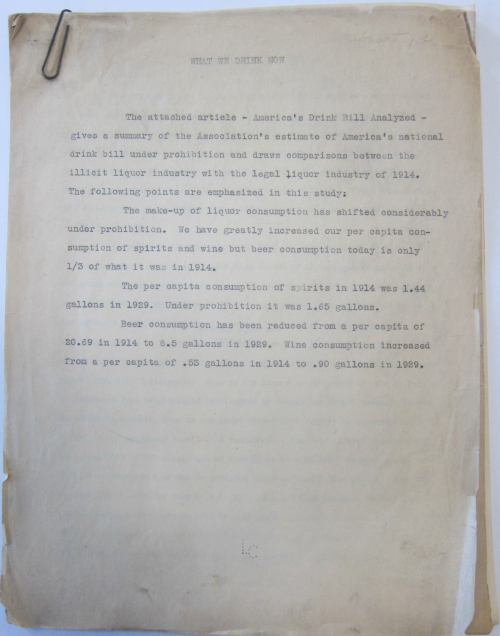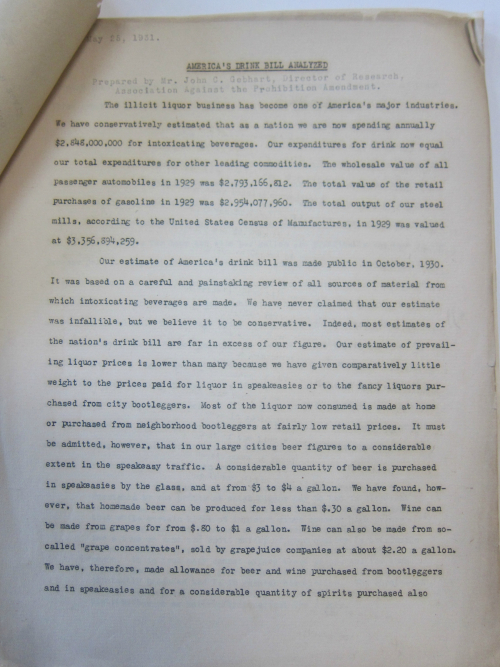John C. Gebhart. "What We Drink Now. America's Drink Bill, Analyzed."
11x8.5", offset printed on sheets, 14pp. Dated May 25, 1931. Provenance: the copy of explorer, Senator (CT), and Mayan expert Hiram Bingham, via the Library of Congress; the paper-clip-bound sheets have a small gift notice from Bingham on the back of the first sheet, plus the LC's surplus stamp on the back page, and the small perforated "LC" on the first/front leaf. Outside of little edge wear and dusting to the first sheet, a VG copy.
 Gebhart was the Director of Research for the Association Against the Prohibition Amendment. Founded by William Slayton, the AAPA "...was the leading political pressure group helping to secure repeal of the Eighteenth Amendment to the U.S. Constitution. Historians credit the AAPA with fostering Republican-Democratic polarization on the issue, giving repeal greater respectability, and greatly speeding up the repeal process...The Association Against the Prohibition Amendment (AAPA) was the leading political pressure group helping to secure repeal of the Eighteenth Amendment to the U.S. Constitution. Historians credit the AAPA with fostering Republican-Democratic polarization on the issue, giving repeal greater respectability, and greatly speeding up the repeal process."--Encyclopedia dot com
Gebhart was the Director of Research for the Association Against the Prohibition Amendment. Founded by William Slayton, the AAPA "...was the leading political pressure group helping to secure repeal of the Eighteenth Amendment to the U.S. Constitution. Historians credit the AAPA with fostering Republican-Democratic polarization on the issue, giving repeal greater respectability, and greatly speeding up the repeal process...The Association Against the Prohibition Amendment (AAPA) was the leading political pressure group helping to secure repeal of the Eighteenth Amendment to the U.S. Constitution. Historians credit the AAPA with fostering Republican-Democratic polarization on the issue, giving repeal greater respectability, and greatly speeding up the repeal process."--Encyclopedia dot com
Gebhart's work was one of numbers, and didn't concentrate at all int he reasons--many of which were sound--for the 18th amendment in the first place. He points out the U.S. alcohol consumption was actually up, from 1.44 gallons in 1929 to 1.65 gallons in 1931. In some compelling comparisons, he writes the illicit liquor produced more sales than wholesale auto sales figures (per year), and about 2/3 "the total output of our steel mills", and that making booze was a flourishing industry that produced massive amounts of crimes (citing Al Capone) and no tax revenue. Anyway there's 14pp of similar evidence, which I guess helped bring about the repeal of the 18th amendment with the adopted of the 21st in December 1933.





Comments